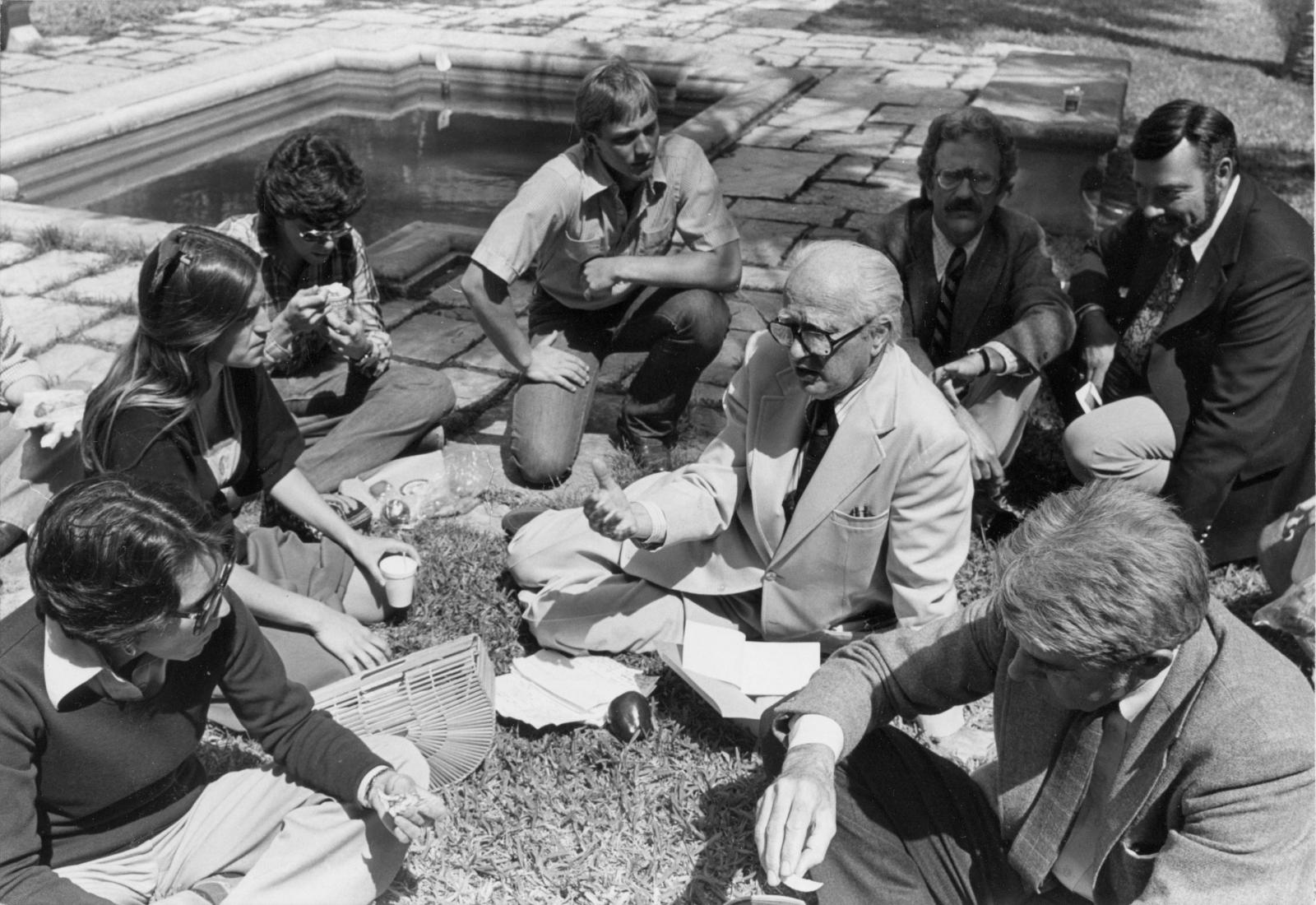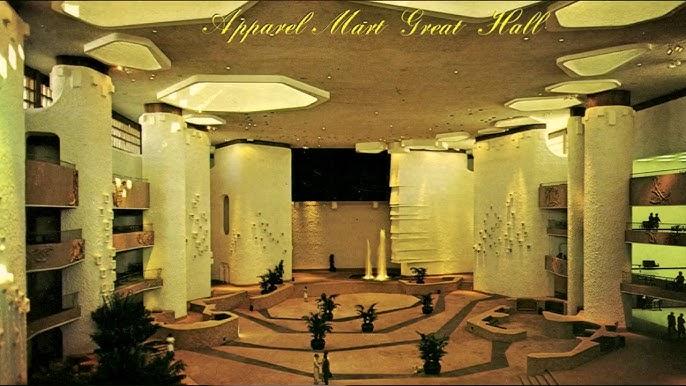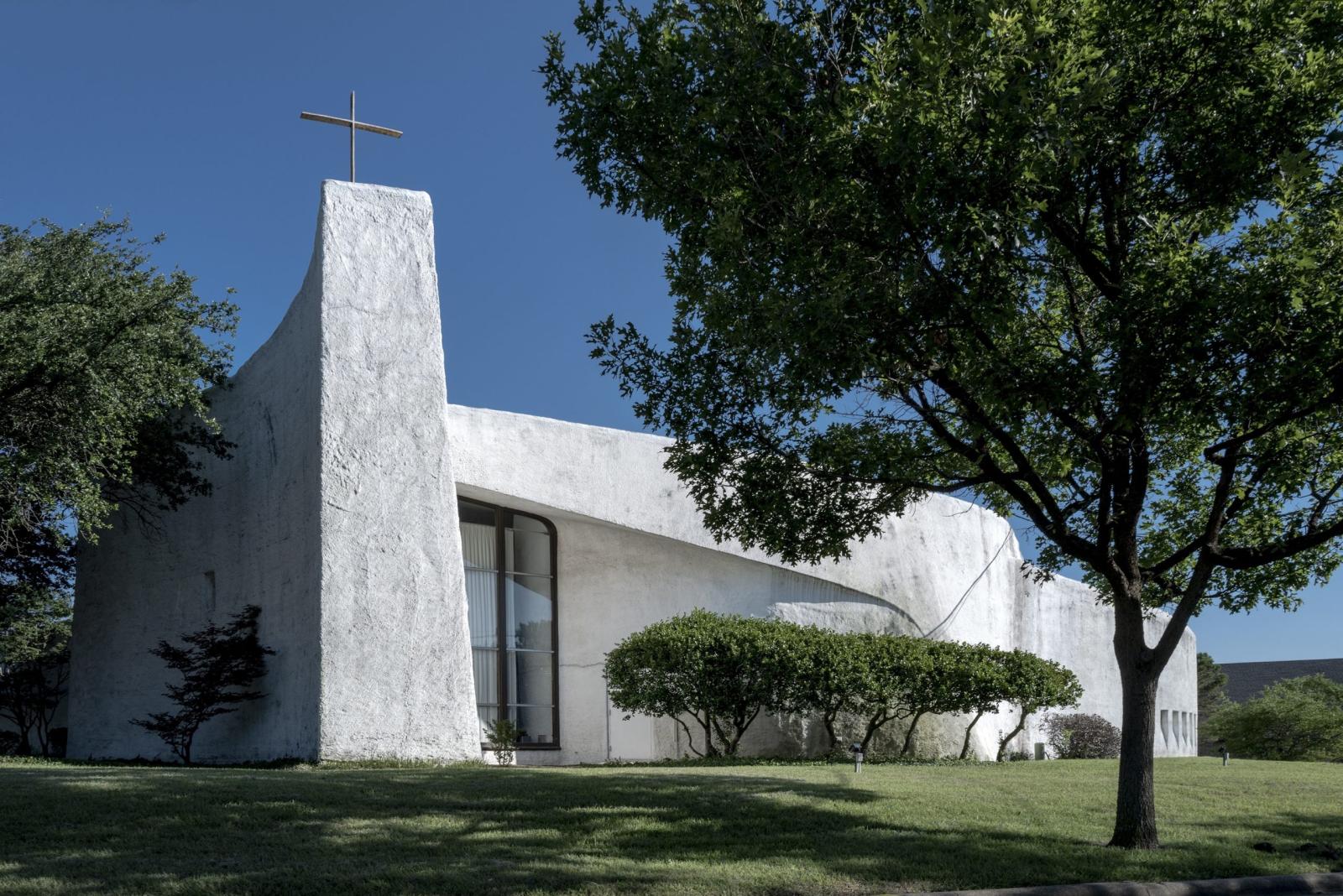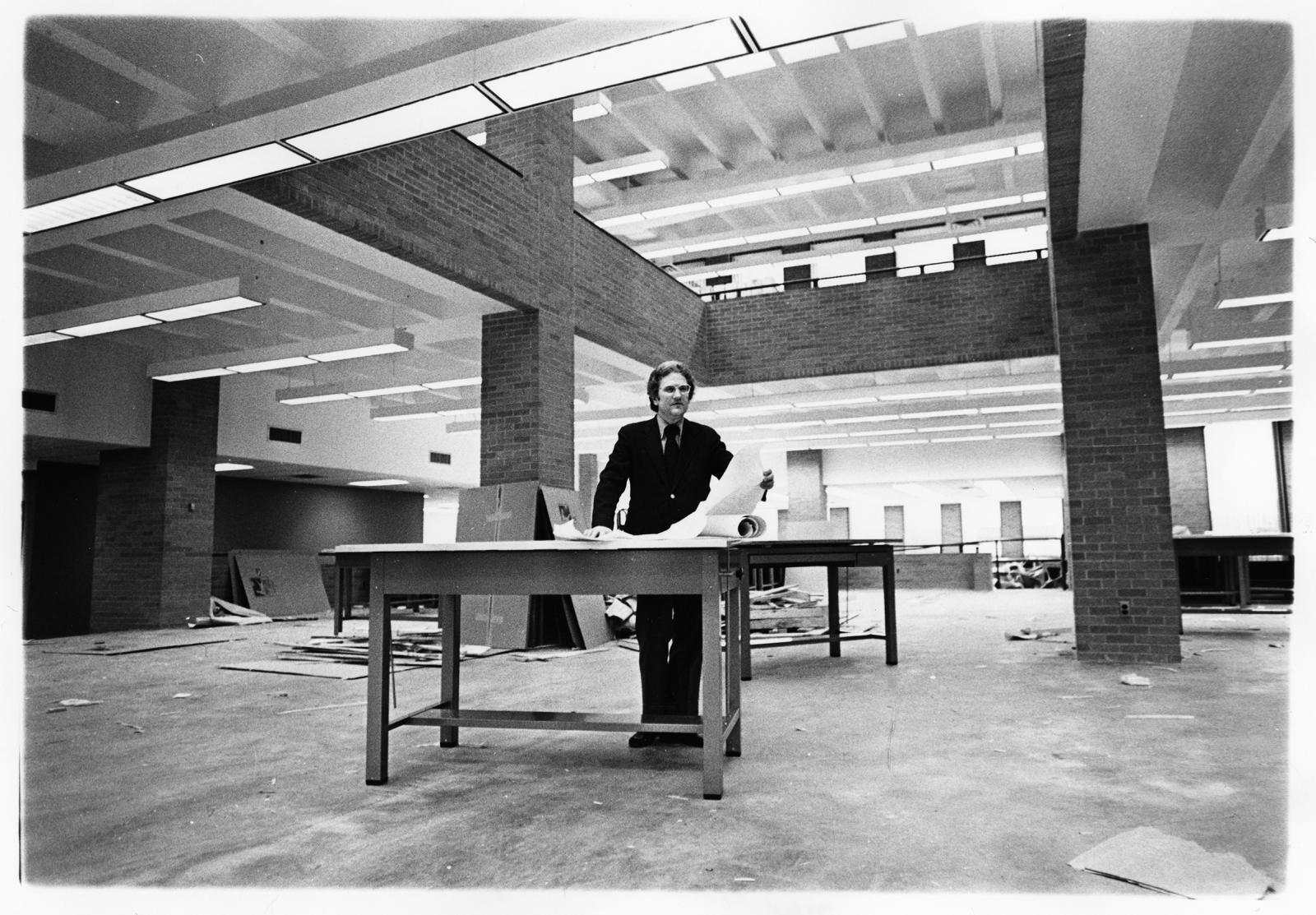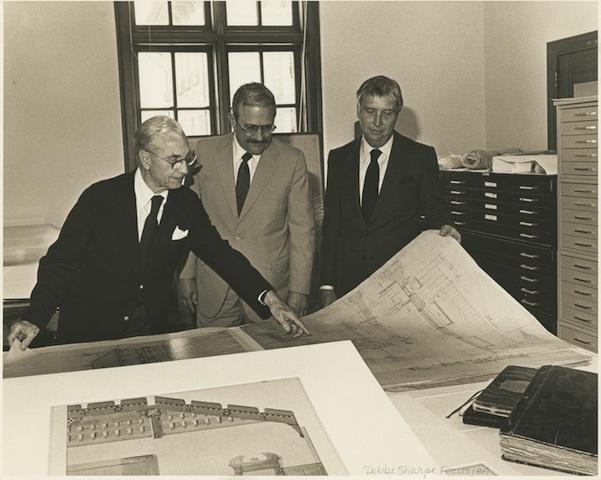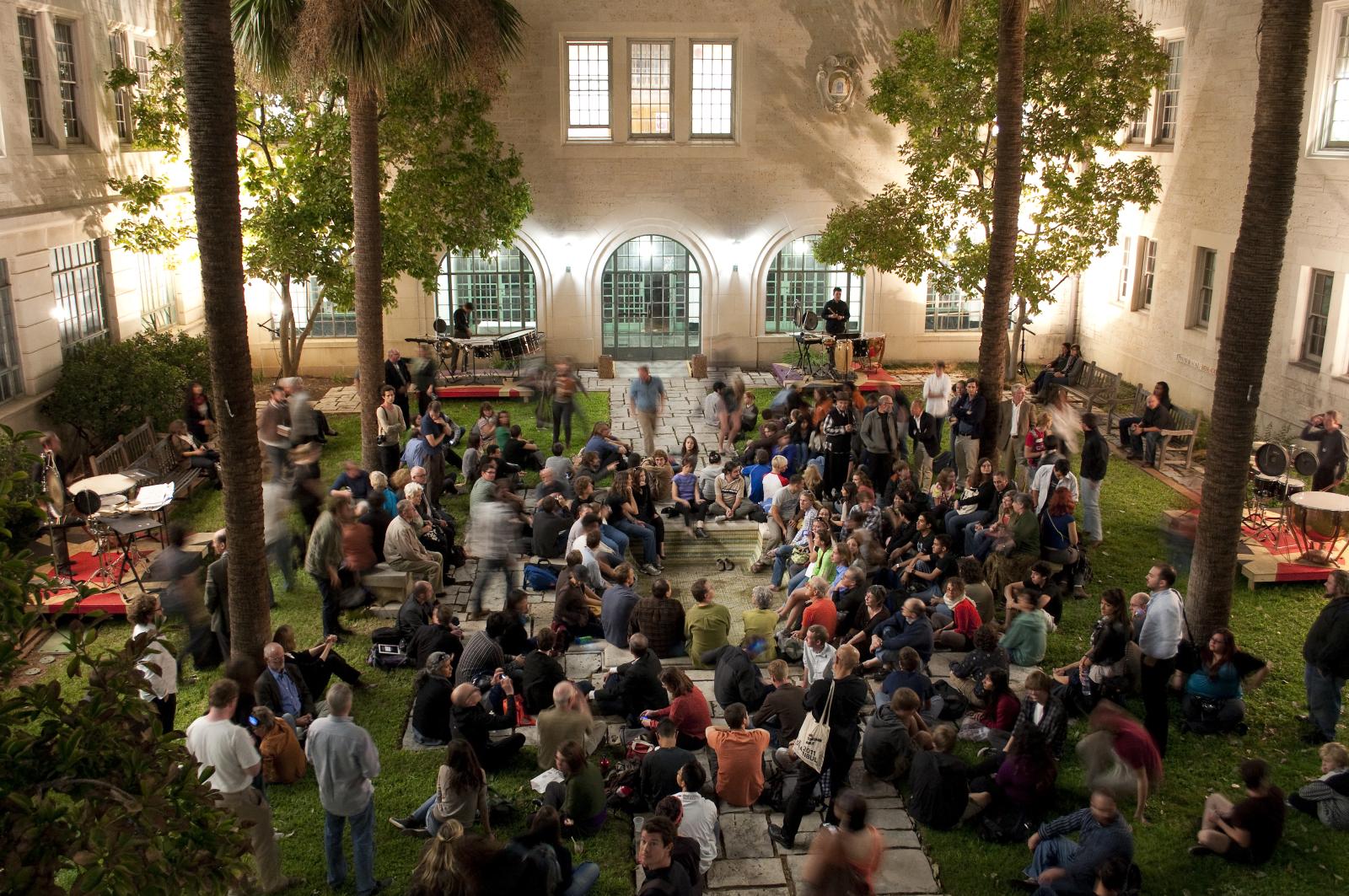Hal Box, Our Beloved Courtyard’s Namesake
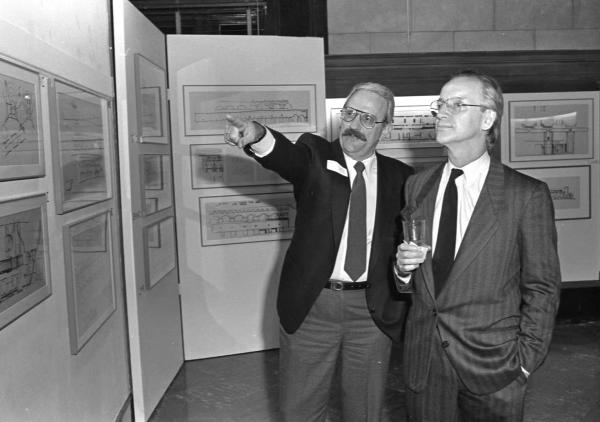
The courtyard in Goldsmith Hall has served as the magnetic heart of the School of Architecture since its completion in 1933. Designed by Paul Cret, the space has been the backdrop for countless community gatherings and class discussions for decades. The Saucer Magnolia trees’ annual blooms offer a pleasant pink respite each spring, drawing visitors from within and beyond the School of Architecture. As beloved as the courtyard has been for generations of students, it became even more significant in 2011 when it became an ode to the impact of the legendary architect, educator, and former Dean: Hal Box.
Dean Emeritus John Harold (Hal) Box led the School of Architecture from 1976-1992, followed by six years of professorship until his retirement in 1998. Box’s impact was swift and intentional, securing both Sutton and Battle Halls as part of the School of Architecture and establishing a dedicated branch for the Architecture and Planning Library (now the John S. Chase Architecture and Planning Library). He listed these priorities as essential conditions for his acceptance of the deanship in 1976, launching an unprecedented chapter of growth and enrichment that established SOA as we know it today.
Born in 1929 in Commerce, Texas, Hal Box attended the University of Texas at Austin and earned a five-year degree in architecture in 1950. In the summer of his third year, he apprenticed with the legendary architect O’Neil Ford, who had just begun his transformation of the Trinity University campus in San Antonio. As a student, Box also worked for Charles Granger, who apprenticed under Richard Neutra and Eero Saarinen. After graduation, Box served on the United States Navy Civil Engineer Corps in aircraft structural design.
Before becoming an educator, Box co-founded the influential Dallas firm Pratt, Box and Henderson (PBH) in 1961. The firm was the vanguard of design and planning initiatives at the time, significantly influencing the growth of the city. PBH was known for considerate design work that was rooted in the climate and culture of Texas with ambitious modern expression. Notable built projects include the now-demolished Apparel Mart and the lively Olla Podrida arts mall as well as the 1966 Quadrangle shopping center, which was Dallas’ first mixed-use development (now a bit unrecognizable after a 1980s renovation and decades of surrounding growth). While these character-filled spaces can only be experienced in photographs, one can still visit the Brookhaven College campus, the St. Stephen’s Church in Mesquite, and the Texas Discovery Garden at Fair Park. Author and critic Mark Lamster reflected on PBH in his column for the Dallas Morning News: “The magic of the architects James Pratt, Hal Box and Philip Henderson was not so much the thoughtful work they built, but what they suggested Dallas could be: a place of creative invention and human scale.”
Box's commitment to the transformative potential of great design led him to become chairman of a new Department of Architecture at The University of Texas at Arlington in 1970. At the time, Dallas-Fort Worth was the largest urban area in the United States without an existing architecture school, and just three years later, the School of Architecture and Environmental Design at the University of Texas at Arlington became accredited under his stewardship.
While Box was content in his position in Dallas, he was invited to interview with University of Texas at Austin President Lorene Rogers for the School of Architecture deanship in 1976. Being “not much interested in the job” led Box to express his candid and critical evaluation of the school’s needs, which, to his surprise, was promptly agreed upon by President Rogers as she offered him the job that same afternoon. Hal Box accepted the position upon the administration’s agreement to his steadfast conditions: the renovation and expansion of Goldsmith and Sutton Halls, the complete dedication of Sutton to the School of Architecture, a new library specifically for architecture that would live within Battle Hall, and a larger budget for faculty, staff, and deanship. He was adamant about the changes needed to keep up with advancements in architectural practice and pedagogy, championing the ambitious renovation projects to Sutton and Goldsmith Halls by Thomas, Booziotis and Associates with Bill Booziotis (BArch ‘57) at the helm.
With each of Box's priorities honored, the school rapidly became the only public university to rank in the top 10 in the nation in both its graduate and undergraduate programs. He expanded the school to include interior design and landscape architecture, made historic preservation a degree program, developed doctoral programs, and raised the school’s endowment to $6 million during his tenure as dean. Shortly after his retirement in 1998, the Hal Box Chair in Urbanism was established—a position held by the late Michael Benedikt.
The Eden and Hal Box Courtyard at Goldsmith Hall is symbolic of the unwavering leadership of the many visionaries who made the school what it is today, and it is important to also note its significance as a space for remembrance: for Hal Box, for Kent Butler, Stacy Barnett, Brandon Shaw, for Michael Benedikt, and others. Their legacies are a part of our school’s story, and each one plays an important role in our collective history.
Functioning as the common forum for the School of Architecture (and those who wish to be photographed in front of it), the courtyard holds immense purpose for both formal and informal gatherings. Box reminisced in the school’s centennial publication “Traces and Trajectories” (2010) that “there was a time when, if I wanted to have an all-school meeting, I simply asked the president of the Student Council to buy a keg of beer and put it in the middle of the courtyard—the studios would empty instantly and everyone would assemble in the courtyard.” Today, the courtyard continues to provide space for quiet moments and intentional gatherings for students, faculty, and staff alike, reminding us of our strength as a community and our shared vision for a better future.
On April 8th, 2011, Box was invited back to campus for a reception to announce the renaming of the Goldsmith Courtyard as the “Eden and Hal Box Courtyard." Honoring his dedicated legacy to the school’s growth and prosperity, the renaming monumentalized his role in our collective success with special mention of the meaningful support of his wife Eden. It was a surprise announcement during the reception that Box would be named Dean Emeritus, an exceptional title bestowed upon very few exemplar members of UT leadership. The timing of these honors was poignant, as Hal Box passed a month later on May 8, 2011, at the age of 81.
We invite you all to take some time within the Eden and Hal Box Courtyard to observe the changing light of the seasons and enjoy a moment of reflection.

